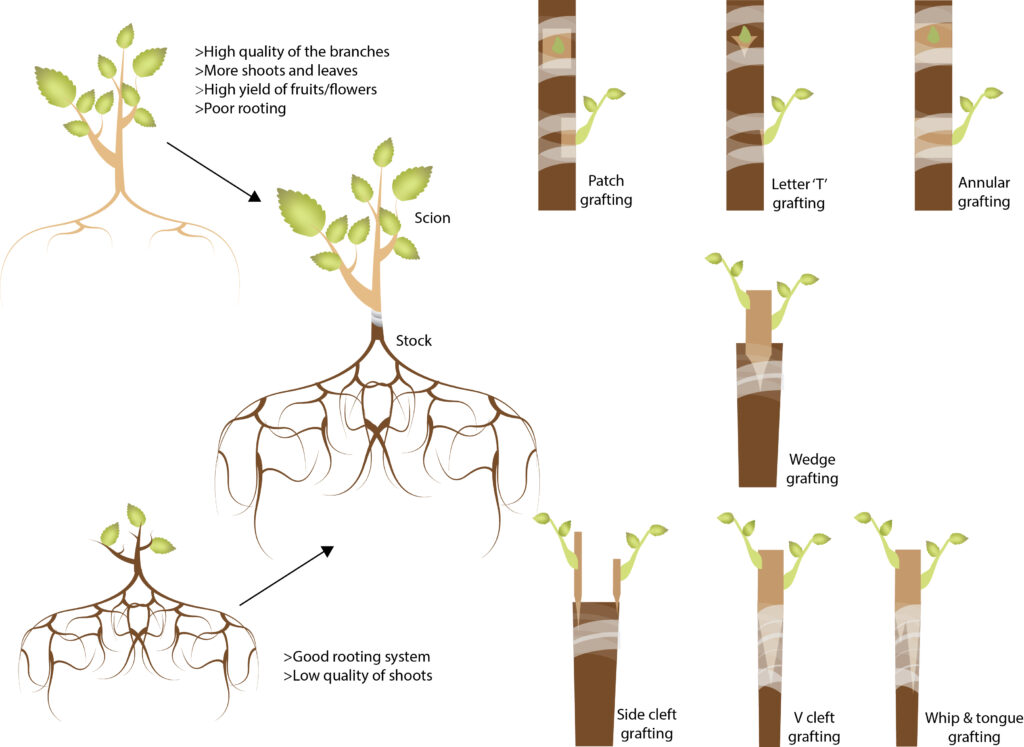Grafting involves two plants of closely related species. It is done by uniting the young part of a plant such as an axil, terminal bud, or young shoot into other plants of the same species or genus. The stock plant is the lower part (or mother plant), and scion, which is the bud or shoots that will be growing on the stock and bear fruits.
Grafting has the benefits of combining the best traits of two species. For instance, the scion, as the performer can be the species that produce fruits at a high quality but with a poor rooting system and the stock plant, as the supporter usually has a strong rooting system. But be prepared to trim off any new growth found on the stock to avoid confusion during the harvesting period. The criteria to choose a good stock plant usually targeting on excellent drought and salt-tolerant ability apart from a good rooting system. With more advanced facilities, in vitro grafting in a laboratory also proved to be a great approach to produce grafted plants without the risk of getting an infection due to exposure to wild nature.
Grafting can be conducted at a high success rate by ensuring the cambium of the scion is attached in harmony with the cambium of the stock plant. The cambium will grow into mature vascular tissue, which serves as the bonding between the two species. The cambial growth is dominantly controlled by the cambium of the stock plant.
There are several types of grafting:
∙Shoot grafting. This method is to combine the shoot from other plants with high quality to the stock. The work can be done on two individual young plants or a seedling attached to a mature plant. The stock plant must be obtained from the local variety with a strong rooting system, whereas the scion chosen must be from the best variety.
∙Bud grafting. This method is usually used to propagate fruit trees and flowers like Bougainvillea. This method allowed many seedlings can be produced from one mother plant. In addition, bud grafting can be further categorized into:
(i) Patch grafting.
Scion with some of its bark containing axillary bud is inserted into the stock plant that is already cut in a rectangular shape. The size of the scion must be perfectly fit into the insertion at the stock. The scion is tightened and secured on the stock using a string and then a cover is used to protect them from direct sunlight and dryness.
(ii) Letter “T” grafting
The scion is cut into an equilateral triangle shape containing a new growth while the stock skin is cut lengthwise and crosswise at the top to make a “T” cut. The scion is then inserted in the cut and secured tightly with a string around the stem.
(iii) Wedge grafting
This grafting method is suitable for the plants that the bark is not easily peeled. The axillary bud of the stock plant is removed, and the scion with a wedge shape is inserted and make sure both the cambial layers can be connected perfectly.
(iv) Annular grafting
This grafting method is preferred on the plant species with easily peeled bark from the wood in which the ring of the bark containing bud (circular scion) is stick fully or partly into the stock and secured tightly.
∙Cleft grafting. This method is not widely used in horticultural practice. However, there are three recorded ways to make it.
(i) Side cleft grafting
This method served to rejuvenate old plants as an alternative and to avoid laborious and expensive replanting exercise. It is a less costly and faster way to produce fruits. It is commonly applied by rejuvenating old apple and pear trees. It is done by cutting the scion about 15 cm with a slant cut at the base of the scion. It is then inserted into the vertical split between the bark and wood of the stock plant (the circumference of the stock). The graft is protected by covering with a plastic bag from the pests, rain, and splashing water that would indirectly lead to diseases.
(ii) V cleft grafting
This would be straightforward and easy cleft grafting in which the base of the scion is trimmed into a letter “V” cut and inserted into the defoliated stock plant. It is then secured by wrapping both the scion and stock tightly. It can be used on Bougainvillea and roses.
(iii) whip and tongue grafting
This grafting method is similar to that of V cleft grafting, but the base of the scion is cut into one side of the plant instead of two sides like a V-shape.
